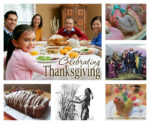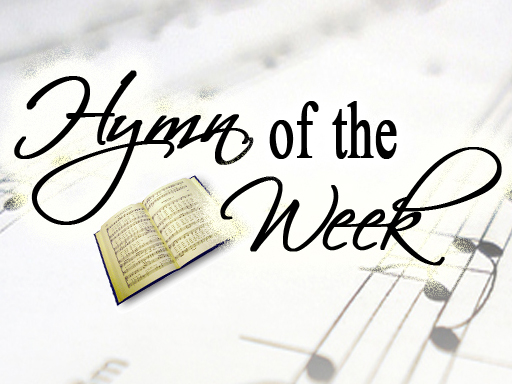Thanksgiving History
It may come as a surprise to learn that Americans did not associate their Thanksgiving celebrations with the Pilgrims until after the mid-19th century (when Rev. Alexander Young looked back in history and identified the harvest celebration of 1621 as the “First Thanksgiving”).1 Ironically, the Pilgrims would not have considered their feast an actual “thanksgiving” (which, for them, would have involved church services and devotion), nor did they celebrate annually thereafter.2
Despite the fact that the connection between the Pilgrims and our Thanksgiving holiday has a complicated history (see alden.org), it seems that Pilgrim practices did in fact contribute to the development of New England thanksgiving celebrations – essentially a tradition that merged a harvest feast with the religious practice of setting aside a day of thanks to God for his kindness and provision. To learn more about the Pilgrim association with Thanksgiving, as well as the fascinating account of their journey to and settlement in America, see our Story of the Pilgrims page.
New England autumn thanksgiving celebrations eventually spread to other colonies, and by 1777, the Continental Congress issued their first congressional Thanksgiving Proclamation. By 1784, Congress had issued 7 more Proclamations (you can view these proclamations at www.pilgrimhall.org). By 1789, Congress urged President George Washington to issue a presidential Thanksgiving Proclamation. It is, in part, as follows:
“Whereas it is the duty of all Nations to acknowledge the providence of almighty God, to obey his will, to be grateful for his benefits, and humbly to implore his protection and favor . . . . Now therefore I do recommend and assign Thursday the 26th day of November next to be devoted by the People of these States to the service of that great and glorious Being, who is the beneficent Author of all the good that was, that is, or that will be – That we may then all unite in rendering unto him our sincere and humble thanks – for his kind care and protection” (see the full text of Washington’s Thanksgiving Proclamation).
Though subsequent presidents made thanksgiving proclamations, the holiday was essentially a regional observance until 1863 when it finally became a uniform, national holiday. Sarah J. Hale, editor of Godey’s Lady’s Book, is credited with being the most instrumental person in the establishment of the national Thanksgiving. Ms. Hale spent many years campaigning for it – writing letters to governors and presidents, as well as editorials (see her inspiring 1863 editorial).
President Lincoln responded in 1863 by setting aside the last Thursday of November as a day of thanksgiving. Lincoln’s proclamation has special significance when considered in its context. America was in the midst of a Civil War. There had been a tremendous loss of life on both sides, and it would be two more long years before the Civil War would end.
During this difficult time in American history, President Lincoln sought to begin the healing process for a divided nation with a call to unite in giving thanks to God. Here are his words, in part:
“The year that is drawing toward its close has been filled with the blessings of fruitful fields and healthful skies. To these bounties, which are so constantly enjoyed that we are prone to forget the source from which they come, others have been added which are of so extraordinary a nature that they cannot fail to penetrate and soften even the heart which is habitually insensible to the ever-watchful providence of Almighty God . . . . No human counsel hath devised nor hath any mortal hand worked out these great things. They are the gracious gifts of the Most High God, who, while dealing with us in anger for our sins, hath nevertheless remembered mercy” (see the full text of Lincoln’s Thanksgiving Proclamation).
Historian David Barton notes that this “remarkable Thanksgiving Proclamation came at a pivotal point in Lincoln’s spiritual life. Three months earlier, the Battle of Gettysburg had occurred, resulting in the loss of some 60,000 American lives. It had been while Lincoln was walking among the thousands of graves there at Gettysburg that he first committed his life to Christ.”3
Lincoln wrote in a letter to a clergyman:
“When I left Springfield [Illinois, to assume the Presidency], I asked the people to pray for me. I was not a Christian. When I buried my son, the severest trial of my life, I was not a Christian. But when I went to Gettysburg and saw the graves of thousands of our soldiers, I then and there consecrated myself to Christ.”4
For the next 78 years, American presidents faithfully followed Lincoln’s precedent and annually declared a national Thanksgiving Day. However, dates varied, so in 1941 Congress permanently established the fourth Thursday of November as the national Thanksgiving holiday.
May we as a nation ALWAYS remember the One to whom our thanks is due, and may we heed His words in Deuteronomy:
“When you have eaten and are satisfied, praise the LORD your God for the good land he has given you. Be careful that you do not forget the LORD your God, failing to observe his commands, his laws and his decrees that I am giving you this day. Otherwise, when you eat and are satisfied, when you build fine houses and settle down, and when your herds and flocks grow large and your silver and gold increase and all you have is multiplied, then your heart will become proud and you will forget the LORD your God” (Deuteronomy 8:10-14a).
NOTE: To learn more about the Pilgrims and their association with Thanksgiving, as well as the fascinating account of their journey to and settlement in America, see our Story of the Pilgrims page.
This page was created by:

We welcome your ideas! If you have suggestions on how to improve this page, please contact us.
You may freely use this content if you cite the source and/or link back to this page.
NOTES:
1 Baker, James. Thanksgiving, The Biography of an American Holiday. University of New Hampshire Press, 2009, p.13.
2 The term “pilgrim” was first used by William Bradford, governor of the Plymouth Plantation, to describe the members of his church – Puritans who traveled from England to Holland and then on to America seeking religious freedom. Though the name has come to be associated with all of the Plymouth Plantation colonists, it is mainly used in this article to refer to the Puritan church members.
3 Barton, David. “Celebrating Thanksgiving in America.” Wallbuilders, November, 2008.
4 Lincoln, Abraham. The Lincoln Memorial: Album-Immortelles. G.W. Carleton and Company, 1882, p. 366.
IMAGE CREDITS:
“Freedom From Want,” by Norman Rockwell at Wikimedia Commons.
“Portrait of George Washington,” by Gilbert Stuart Williamstown at Wikimedia Commons.
“Portrait of Sarah Josepha Hale,” by James Reid Lambdin at Wikimedia Commons.
Photo of Abraham Lincoln by Alexander Gardner at Wikimedia Commons.








